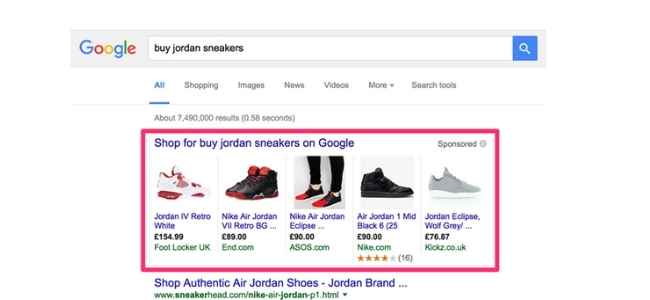Google is without a doubt the best platform to advertise your products. It is the most popular online search engine and therefore the first place people are most likely to come if they are looking for a product, which corresponds to 3.5 billion global search queries during the day. In addition, through the Content Network, Google delivers ads to the myriad of sites your potential customers visit. So why not use his services to promote your products?
One way to do this is with classic Google Ads text ads. However, if you have a large inventory, this option is not very effective for you. Therefore, you should choose Google Shopping Ads. We’ll explain below what this is and how easily you can launch your first campaign today.
What do you need
The first thing you need to do is to set up your Google accounts. If you do not have GMAIL we recommend you to create your own account. With this account, you will be able to login under every Google service such as Google Ads, Google Merchant Center or Google Analytics.
To create a Google Ads account you need to follow a few steps. After you are done with that, the next thing you should do is to create a Google Merchant Center where you will upload and manage your product inventory. Now you will be able to connect your Google Ads and Google Merchant account.
The last thing you should do is to create your Google Analytics account. There you will be able to track your website visits, conversions, where you are keeping your audience most interested and many other statistics.
If you wondering, how your product feed should look like, here is the example:
- Identifier (ID): the number under which you register the product in your e-shop.
- Name: A name that matches the name of a specific product in your e-shop, including color or model.
- Description: product information that should match the description of your product on your website (eshop).
- Link: The URL of a specific product website, beginning with http or https.
- Image link: The URL of the main product image, starting with http or https.
- Availability: Your product will only be advertisable if it is available.
- Price: The price must match that in your e-shop and must be in the currency that corresponds to the country in which you are advertising.
- Google product category: Specify a specific product category.
- Brand: the brand of a product as known to customers.
Now you should be ready to start your first campaign.
What are Shopping Ads and how they work
Shopping ads are a type of automated advertising on Google that can be used by e-shop owners. They appear on Google Search as an image, title, price, and link to your site. Customers thus have the opportunity to compare the searched product between different sellers already in the Search. After clicking on the selected product, customers are redirected directly to the seller’s e-shop, where they can purchase it.
Unlike Etsy, Ebay or Amazon, Google Shopping is technically an advertising platform, which, however, offers the possibilities of the mentioned virtual shopping centers. Users can browse the products of different vendors on Google Search or on sites in the Google Content Network.
So they work on the principle of classic ads on Google – you enter a set of products that you sell, you set a price for it, which you offer for their display. And if this amount is optimal, your products will be displayed if someone searches for them. Paying for an ad also works on a cost-per-click basis – you don’t pay to see your ad, but only when someone clicks on it.
However, they differ from traditional text ads in their emphasis on the visual side of the ad. The user will see a picture of a specific product, title, price, store name and some additional information. So there’s no need to create headlines, descriptions, or match keywords. Instead of keywords, Google works with the name of the product and the information you provide.
In addition, this type of ad does not compete with traditional text ads; they appear independently of each other. Ads in Shopping will appear on Search either above or next to search results and text ads, on the right. So if you use text ads at the same time, your product may appear twice in search, making it even more visible.
Benefits of Shopping Ads
Shopping ads have been a direct part of Google Ads, formerly known as Google AdWords, since 2012. They are popular with both customers and advertisers, especially for the many benefits they provide advertisers over traditional text ads. When you post all the necessary product details in your ad, you get customers who are more likely to complete the conversion because they already know which product they can find in your e-shop. Compared to text ads, Shopping ads have up to 30% higher conversion rates.
In addition, setting up campaigns in Shopping is extremely easy. You don’t have to come up with creative titles, descriptions, or search for suitable keywords. The sooner you start using Ads in Shopping, the sooner you’ll see the results you want as a competitive advantage over e-shops that don’t yet use those ads and the higher conversion rates.
For Shopping Ads you can use these bidding strategies
Maximize clicks: This bid is focused on getting the highest number of clicks on your product ads in Shopping. We recommend using this quote for the first 3-4 weeks and later switching to Target ROAS so that Target ROAS Smart Quotes has as much data as possible for further optimization.
Maximize conversions: This bid is focused on getting as many conversions / purchases as possible through ads on Google Shopping. But don’t get confused! This is the highest possible number of purchases, but it does not look at the price that was necessary to make these purchases.
Target ROAS: if you want to achieve a high number of purchases but at the same time keep the lowest possible share of cost of turnover, then use this price offer. It’s a good idea to run ROAS Target only when your Google Shopping campaign has at least 30-40 conversions / purchases in the last 30 days!
Manual CPC: This type of quote is for professionals. It is most often used by PPC specialists and agencies who know exactly how to deal with this tactic. This involves constantly monitoring and tracking the performance of individual products within Google Shopping, and constantly adjusting their CPC bids based on historical performance and revenue from this ad.
Finally, take it that the initial settings you have made are not final and need to be constantly monitored and optimized. Advertising is organic and the environment in which it is displayed is constantly changing – new vendors are added, old ones change bid levels for advertised products, the availability of your products changes, etc. The advantage of shopping ads is that you can get very detailed reports on the performance of your ads, and you can use them to adjust your bid levels or your inventory, for example.
Summarize
As you may have noticed, Google offers a really wide selection of ads and strategies. It’s up to you how you approach it and what you do to move your business forward. We keep our fingers crossed for your first campaign

